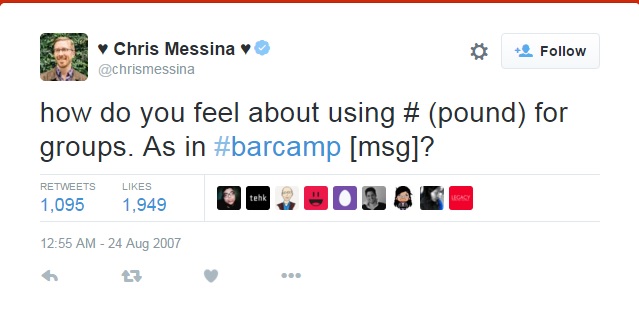Twitter Marketing Tips: How to Tweet Right for Better Engagement
There is a direct relationship between the content you share on Twitter and the engagement it receives – the better your content, greater the engagement. However, with just 140 characters at your disposal, crafting a good tweet needs some thought and practice.
Here are five essential elements of a tweet that will get you noticed:
Deconstructing a ‘good tweet’
1. Text
The headline is the most critical element of a tweet. It gives you the scope to address your audience and capture their attention. Use it judiciously in adding a voice to the content you share. Neil Patel analyzed 398,582 tweets, and found that 93 percent of them were text based.
According to Coppyblogger, “8 out of 10 people read a headline, but only 2 out of 10 will read the rest”. And on Twitter, with a mediocre headline, that number will quite easily fall to zero. For a headline to work, you must present the value your content holds to the reader up front. You could do that with surprise, curiosity, or humor.
Here’s a good example:
2. Link
Research indicates that tweets with links get up to 86 percent more retweets than those without. Adding a link to your tweet is not only important in improving engagement, but is also a way for you to increase traffic to your website. Since content consumption is integral to a user’s experience on Twitter, links are important even when you’re sharing external content, and driving traffic isn’t your sole objective.
When sharing links, it’s a good idea to employ shortened links since it lets you track click-throughs, giving you valuable information about your audience. Once you understand which links are getting clicked on, you’ll be able to align your content strategy to your audiences’ interest, which will help sustain engagement in the long run.
Tip: When sharing links ensure that the content is related to your brand/industry and also of interest to your audience. If your content strategy includes sharing generic content pertaining to everyday life such as motivational articles or simple hacks for daily activities, make sure it isn’t offensive or in bad taste.
3. Hashtags
Using hashtags is a great way to categorize your tweets and make them more discoverable. Hashtags pull all related tweets into a single stream, allowing for conversations even between people who may not be following each other. Experts advise that the use of hashtags should be limited to two per tweet. If you’re feeling a bit enthusiastic, you could may be add a third one, but I wouldn’t recommend it – it’s been found that using more than two hashtags in a tweet can cause a 17 percent drop in engagement rates.
Hashtags have become an important element of Twitter, and their use has spread to other social platforms such as Facebook and Instagram. On Twitter, tweets with hashtags get twice as much engagement than those without. The important thing to remember when using hashtags is that they should be relevant to your tweet. Using irrelevant hashtags in your tweets could have you classified as a troll, and you don’t want that!
For some trivia, here’s the first tweet that ever used a hashtag, needless to say it’s a rather popular one.
4. Images
Twitter’s in-house data scientist, Douglas Mason analyzed millions of tweets from verified Twitter handles. His study indicates that tweets with Photo URLs receive 35 percent more retweets. Using an eye-catching inline image is one of the most effective ways by which you can make your tweet stand out on your followers’ Home pages.
Images in tweets are just as important as you profile photo and your header image. They need to be of high quality and relevant to the content that accompanies them. Images with quotes are good at spurring engagement too. You can also use text-based images to add more detail to your tweet – that’s a rather smart way of beating the 140-character limit!
Here’s an example:
5. Video
Unlike Facebook, Twitter users haven’t always been charmed by videos. But earlier this year, Twitter made a bunch of changes to how users experience videos on its platform. Now, native videos on Twitter are going the same direction as they did on Facebook, but of course not on such a large scale. A survey of top 500 brands by SocialBakers showed that they’re now publishing more videos natively on Twitter than they are on Youtube.
With Google being able to display public tweets in its search results, and videos typically being live, or recent in nature, native videos on Twitter also have a huge implication on your SEO efforts. Twitter created a niche for micro-posts and that extends into its native videos too, so remember you’ll be better off posting short videos.
Save time managing your social media accounts
Are you still managing your social media accounts directly from Facebook/Twitter/LinkedIn? Make your life easier by managing all your social media in one place, schedule posts, repeat posts, curate content and more. Try DrumUp now, it's free, forever.
More best practices for Twitter marketers1. Ask questions
1. Ask questions
Having an active audience is a great learning opportunity. Not only does that give a chance to gain some knowledge from your audience, but it’s also an effective way of getting them to participate in a conversation. And with the recent addition of Polls to Twitter, you’ve got yourself an all new way of reaching out to them and understanding their preferences.
2. Go easy on the memes
Memes are super popular on Facebook, but not so much on Twitter. Especially for brands, memes hold little value since they don’t really turn in any conversions. While they’re witty and humorous, they aren’t very useful from a branding perspective either.
3. Ask to retweet
“Ask and you shall receive” – including the phrase ‘Please RT’ at the end of your tweet serves as a good call-to-action. In fact, Hubspot found that using this phrase at the end of a tweet is likely to generate four times the retweets it would otherwise. It’s absolutely okay to urge your followers with a slight nudge. And if you’re sharing valuable content, you’re followers will be more than willing to oblige.
What other practices have you found to be effective on Twitter? I’d love to hear from you – do share your insights with me in the comments section below.


